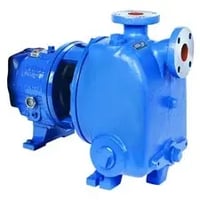Recently, one of our engineers quoted a replacement gear pump, and the customer was puzzled by the...
Stop the Spill: Essential Tips for AODD Pump Reliability

Recently, we toured a manufacturing facility where a graveyard of air-operated double diaphragm pumps lay waiting for repair. Each one was encrusted in product residue, a testament to their failure and the unplanned downtime it caused—an expensive mess to clean up.
We know how annoying it can be, so here are four strategies to help you boost pump reliability and keep operations flowing smoothly. Before getting into the strategies, it's important to understand what's going on.
Why Ruptured AODD Diaphragms Matter
Spills from these positive displacement pumps are a company’s nightmare, impacting both the environment and the bottom line. Cleanup is no picnic; typically, workers toss oil-dry or kitty litter onto the spill, only for someone else to shovel it away later. If hazardous waste is involved, costs skyrocket with the need for proper disposal.
Certain fluids carry hefty fines or disposal fees, including:
- Paints, inks, and coatings
- Chemicals and petrochemicals
- Acids and caustics
- Pharmaceuticals and foods
Losing these fluids isn’t just an inconvenience; it’s a financial hit.
Why Do Diaphragms Rupture?
Running pumps dry is a classic blunder that leads to diaphragm failure—surprising, yet all too common. Another culprit? Over pressurizing the pump. Operators sometimes crank up the compressed air to speed things up, which can cause leaks, bent plates, and, ultimately, ruptured diaphragms.
When a diaphragm tears, fluid floods the air chamber and sprays out, creating a chaotic scene.
Tips to Prevent Ruptured Diaphragms
Understanding the cost of AODD spills is crucial, so here are four expert tips to keep your pumps in check. If you're unsure about the next steps when it comes to your problem pumps, let us know. We can help or find the right AODD pump for your application.
Use a Regulator
Think of a regulator as your pump’s best friend. It controls airflow, moderating stroke speed and extending diaphragm life. Skimping on this can lead to rapid diaphragm failure—and nobody wants that.
Avoid Running Dry
This one is straightforward: running pumps dry destroys diaphragms. Just don’t do it. Ever.
Opt for a One-Piece Diaphragm
A one-piece diaphragm can withstand more pressure and features dimples that allow it to flex, which means longer service life.
Select the Right Pump
Not all air-operated double diaphragm pumps are created equal. Understand your fluid properties and process. For thicker fluids, consider heavy-duty ball valve pumps or containment duty pumps. These are designed to prevent spills and protect your process.
Containment duty pumps have an extra chamber that catches fluid when a diaphragm fails, alerting users without causing a messy spill.
Prevention is the name of the game when it comes to AODD pumps. Proper pump selection, using regulators, and training operators can save you from costly diaphragm failures.
Consult with a Fluid Handling Expert
If you’re battling chronic AODD issues, don’t hesitate to reach out. We’re here to help businesses and municipalities throughout Michigan and Northwest Ohio!



